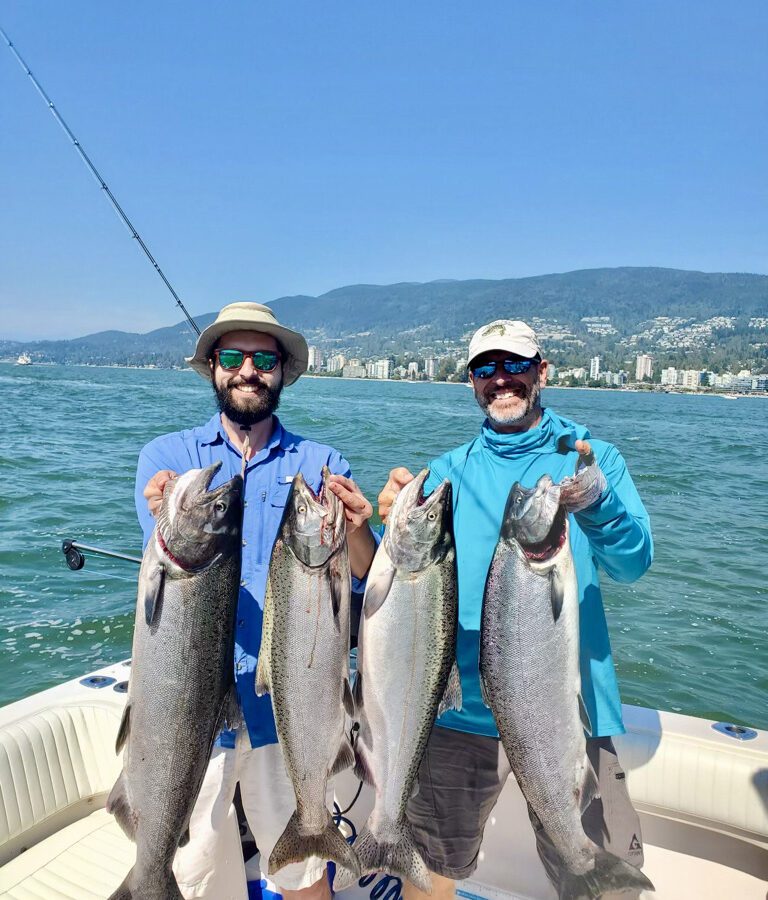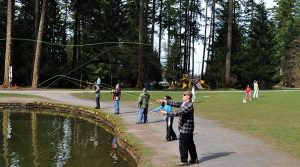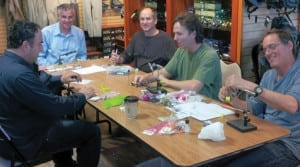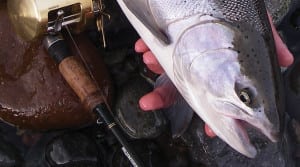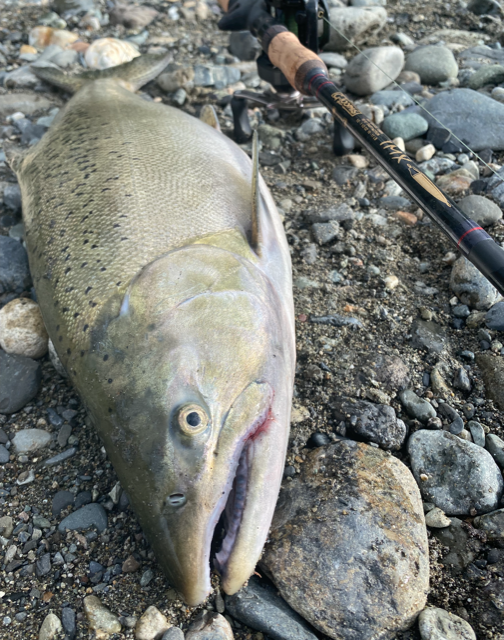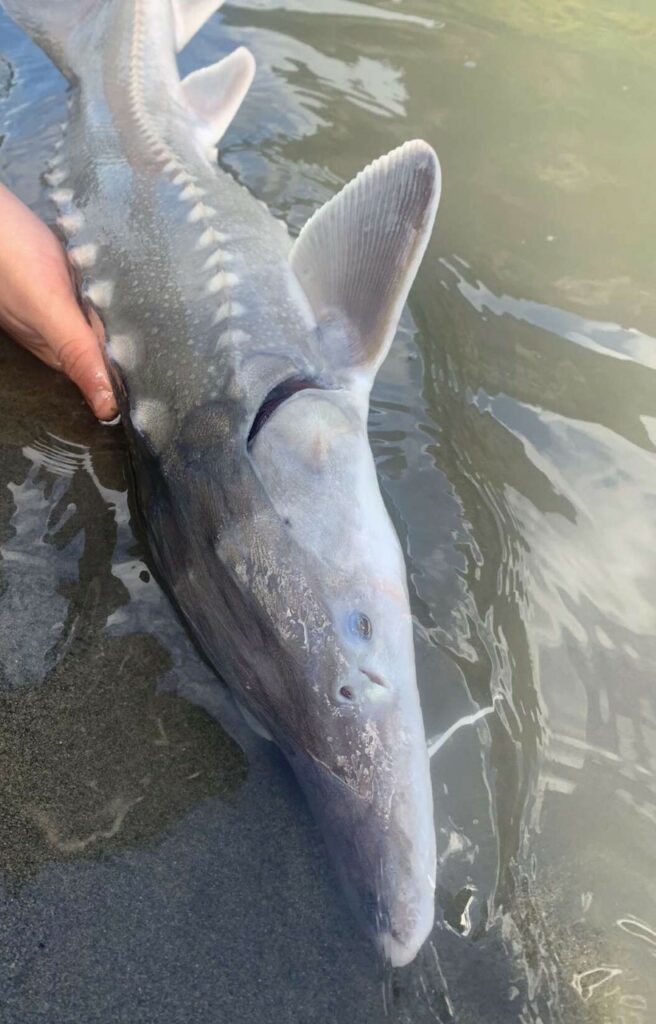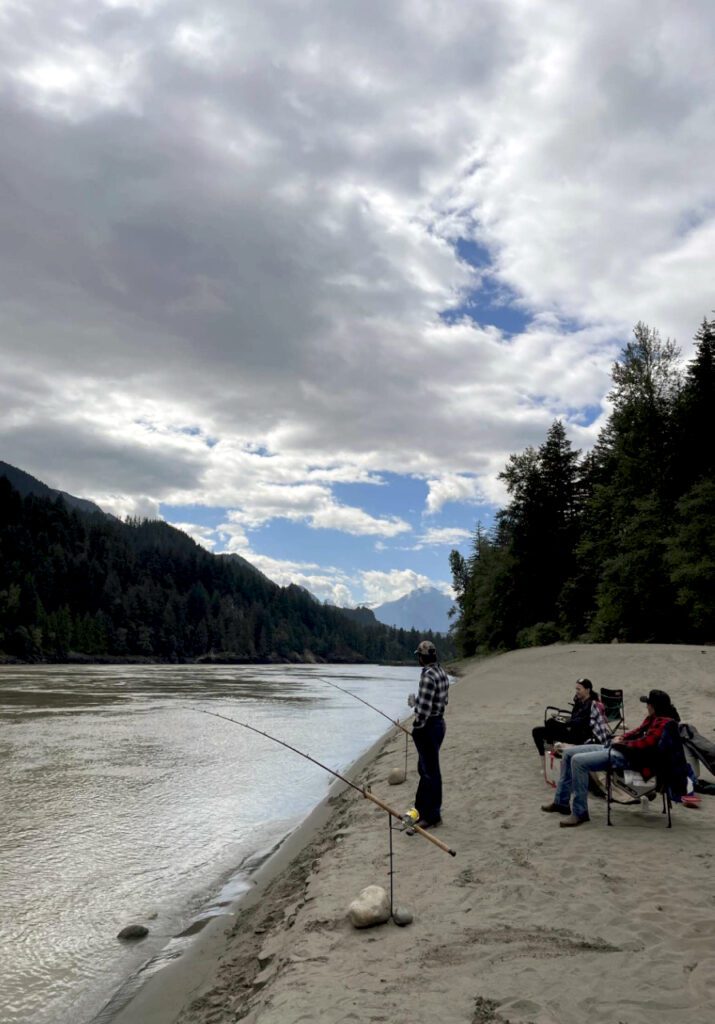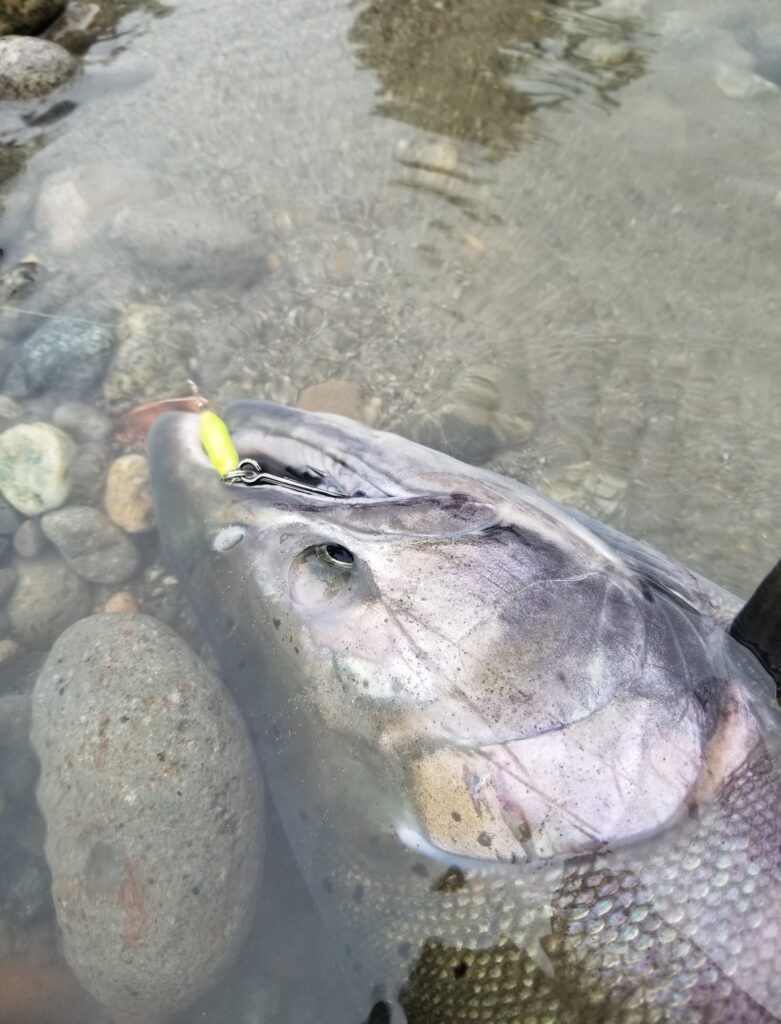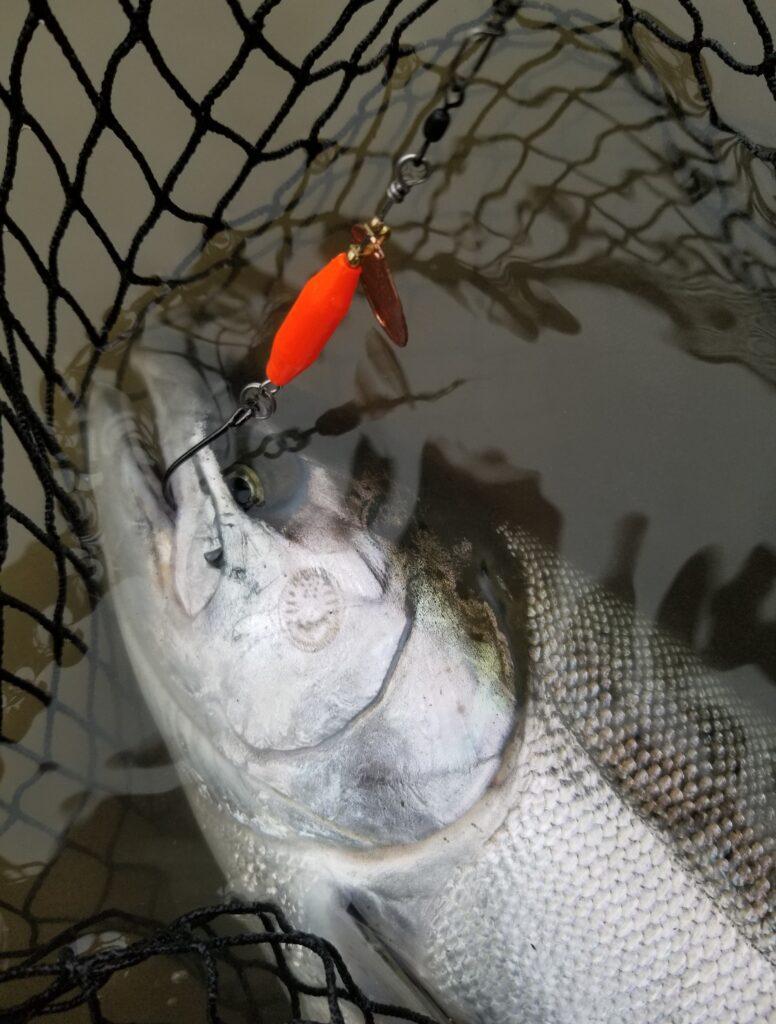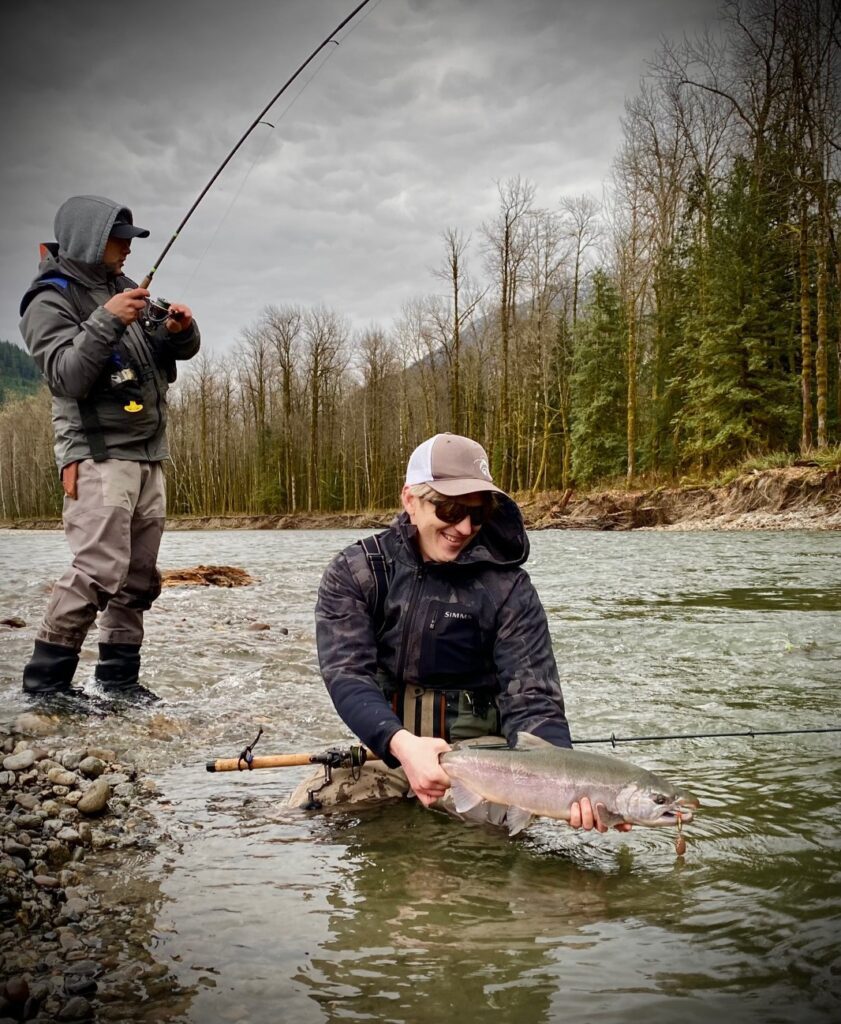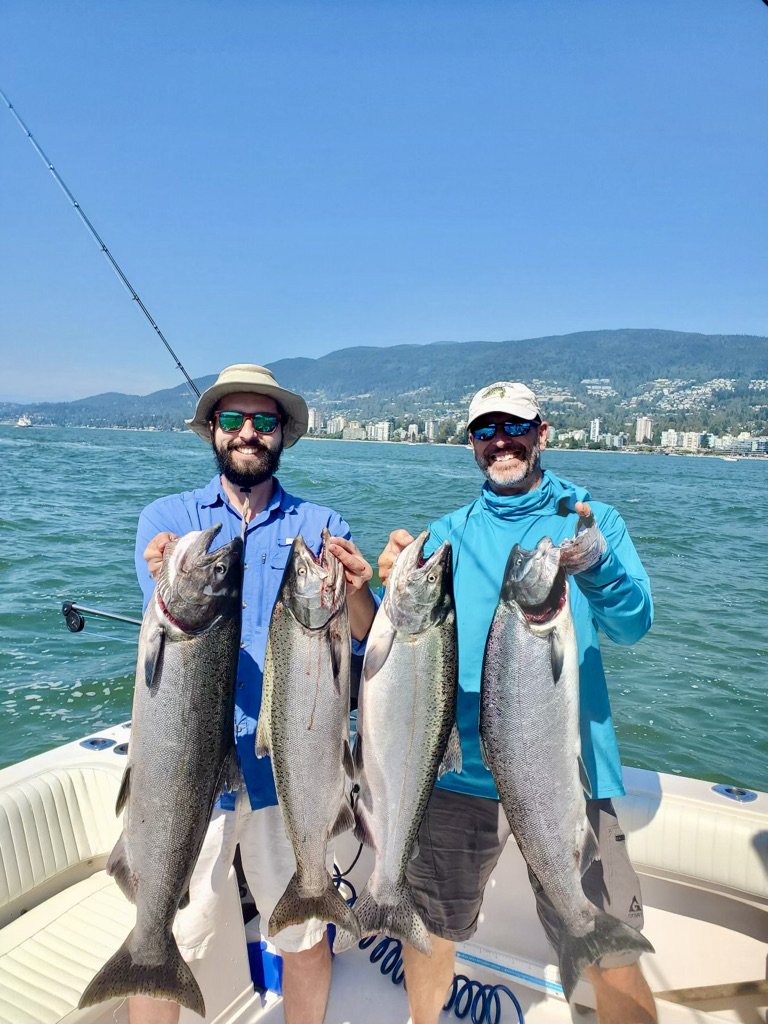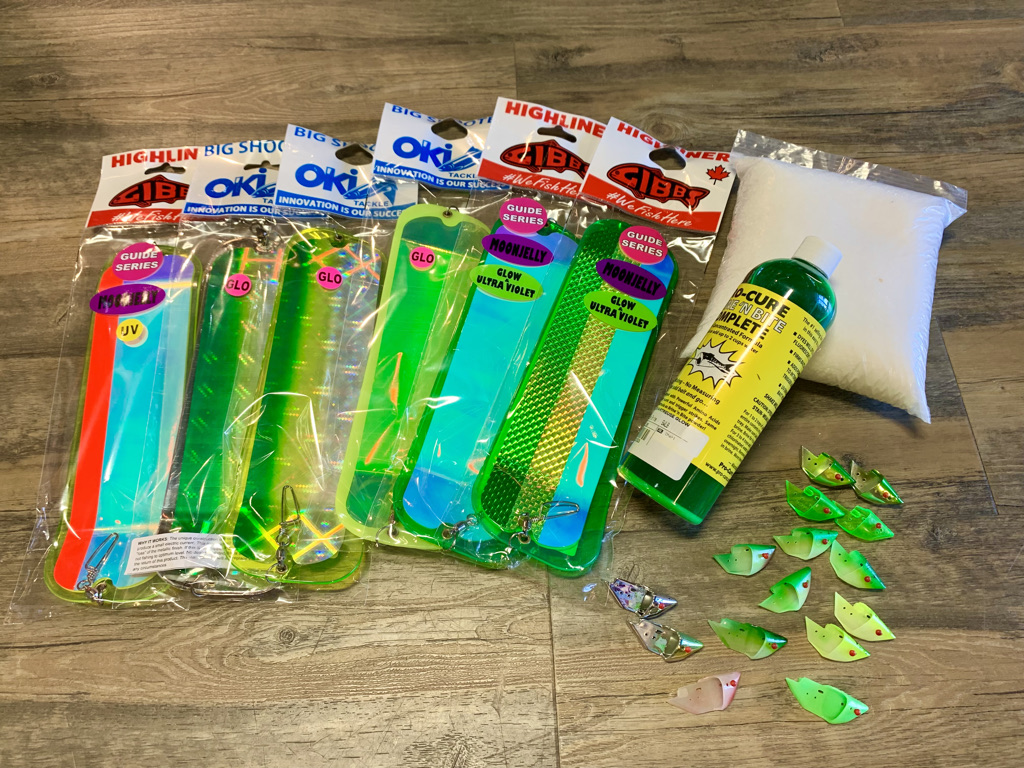OUTLOOK
Chinook fishing is OPEN! Be Sure to have a read of Jason’s saltwater report for the latest on that opening. If you want to brush up on how we fish the late season fisheries make sure to check out the video version of the report where Matt goes over the map and some good general tips on how to set up your gear.
We are also eagerly awaiting fall river salmon season to kick off on the Chilliwack. We have not heard any early reports but scouting missions are worth it right now. It is also worth watching the video version of the report for this one because Matt looks at the Albion numbers and some access issues on Chilliwack. The Albion numbers are not great. We are hoping that a late trend to this season might mean more fish are coming. The fish coming right now are probably not heading to the Chilliwack in any substantial number but if this late trend continues it might mean a slightly later Chilliwack return.
With fall salmon fishing in mind, we also have a great overview of how to use spinners for fall river fishing. Taylor goes into detail with colours, strategies and fishing concepts if you are building out your fall salmon gear kit.
For those thinking sturgeon, that fishery is going strong right now. Ethan has an update for us in this week’s report. Bait is critical because there is lots of food in the river right now but the fish are feeding and on the bite.
If you all didn’t know we have been guiding the lower Fraser for sturgeon for the last couple of months in our jet boat. It’s a great fishery amazingly close to home so if you want to get out now is the time! – Call our charter line at 778-788-8582 to book both saltwater salmon trips and local sturgeon trips.
Lastly, we are open all weekend but closed on Monday so our team can get out on the water.
Please note our Labour Day long weekend hours below:
Friday September 2 | 10AM – 7PM
Saturday September 3 | 10AM – 6PM
Sunday September 4 | 11AM – 5PM
Monday September 5 | Closed for Labour Day! See you on the water!
Remember – if you are dropping into the shop to grab a few items there is a quick load zone directly out front of the shop where you can park for a quick 15-20 min.
To watch the video version of the report, click below:
On to the report!
CLASSES AND COURSES
Our classes have wrapped up for the summer season but we will be back in the fall with these exciting classes. Call the shop at 604.872.2204 to sign up before they sell out.
INTRODUCTION TO FLY FISHING
This course was specifically designed to give the new fly fisher the basic knowledge, casting skills and fly fishing strategies to effectively fish our local BC waters. This course is comprised of two sessions; 3hr evening seminar and a 3hr casting session. The dates below show the seminar date first and casting date second.
Dates: Sept 20 & 24
Cost: $150.00
Zoom Seminar Time: 6:30pm – 9:30pm
Casting Time(s): 10am – 1pm or 1:30pm -4:30pm
INTRODUCTION TO FLY TYING
There is no greater satisfaction than catching a fish with a fly you tied yourself. This Introduction to Fly Tying course was specifically designed to give you the fundamental skills needed to tie proven fly patterns used here in BC for trout, salmon, and steelhead.
This course consists of 3 sessions; each session is 3hrs.
Students are required to supply their own vise, tools and materials. A 10% discount is available on fly tying materials and tools purchased for the course.
Dates: Sep 27, Oct 4, 11
Cost: $80.00+GST
Time: 6:30pm – 9:30pm
FALL SALMON RIVER FISHING: FLOATS, SPINNERS, & SPOONS
This 3hr evening seminar covers float fishing, spinner fishing and spoon fishing; the three most productive techniques to catch BC salmon in a river.
In-Person Seminar: Sep 26, 2022
Cost: $50.00+GST
In Person Seminar Time: 6:30pm – 9:30pm
FRESHWATER FISHING REPORTS
Chilliwack/Vedder River Fishing Report
September 1st cues the opening for a lot of different fisheries, including the fall salmon run on the Chilliwack/Vedder. Chinook retention changes to 4 per day, 2 over 62cm and coho opens to 4 hatchery marked per day. Keep in mind that you may only retain 4 salmon total per day.
The chinook season on the C/V is expected to be excellent. This is the first year we will see the returning adults from the increased production of chinook fry from the Chilliwack Hatchery.
Typically, the first waves of fish starts to push around the 10th of September. Take a look at next week’s report as where we will dive in deep into my top 5 presentations for float fishing salmon in the fall. Go for a walk along the river, with your rod, and do some scouting for the upcoming weeks.
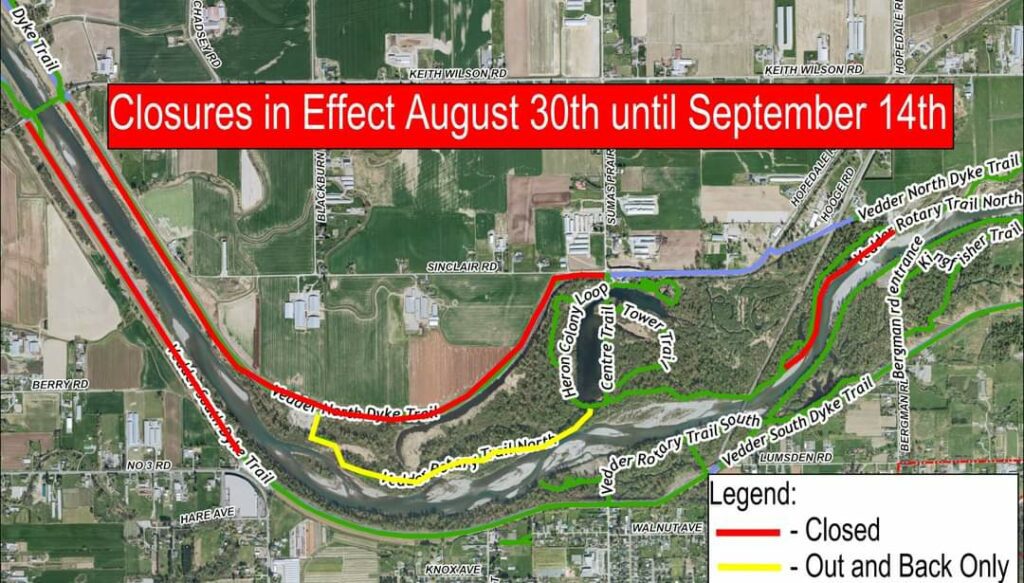
See you on the water,
Gavin Lau
FRASER RIVER STURGEON REPORT
Fraser River Sturgeon Fishing Report
The Fraser River is a great river to spend some time on at the moment. The sturgeon fishing has continued to stay quite productive as of the last few weeks. The fish seem to have been getting a bit tight lipped on certain baits but there are a few tactics you can use to increase your success. As for water levels, historically, it is typically about a meter lower throughout the month of August than it is right now. That said, water levels have been no issue for me throughout the month.
Sockeye have been pushing into the Fraser over the last few weeks. This means there is an abundance of food for sturgeon at this point. I’ve found that when an abundance of food is the case enticing a fish to commit to your bait can be challenging as they do start to get picky.
With that being said using odd bait that isn’t typically used at this time has proven to be beneficial at times. Some of my best days the last week or so have been on eulachons of all things. So, switching up bait and trying different things have proven successful for me. I find around this time of the year that bait seems to be the difference maker over tides and location. Roe has been a consistent producer for me as well which is typically the bait of choice right now as salmon start pushing in. With fall salmon season commencing in the near future more and more opportunities will be had to allow the recreational angler to attain some fresh fish as well as fresh bait. Using fresh uncured roe, salmon belly and salmon heads from fresh caught fish have proven to work excellent going into the fall months.
Nonetheless sitting back, pulling on sturgeon, and hanging out in some warm weather for the last few weeks of summer makes for a fantastic day.
If you’d like to get setup or just talk sturgeon in general make sure to swing by the shop. Also, as mentioned in the outlook, if you’d like to get out for a guided sturgeon trip on our jet boat be sure to call the shop’s charter line at 778.788.8582 for more information or check out our website here!
Ethan Da Silva
SPECIAL REPORTS
Salmon Casting Spinners – An In-depth Look
It’s officially September, and if you’re reading this report, you probably know what that means: it’s finally fall salmon season. While the springs and coho haven’t quite showed up in the rivers in significant numbers, just yet, now is the time to be respooling your reels, tying your leaders and flies, stocking up on essential gear, and making sure all your gear is in working order. I’ve been busy doing all of the above, plus building spinners… both for personal use, and for the store.
Casting spinners are probably one of my favorite types of salmon lures for fall salmon- they’re versatile, simple, and can be hilariously effective. For the uninitiated, a casting spinner is a lure that features a blade that spins freely on a wire shaft, usually in combination with some form of metal body that provides weight. Popular examples include Blue Foxes and Mepps Aglias. They should not be mistaken for trolling spinners, which are built with very lightweight bodies, usually made of plastic beads, and are unsuitable for casting. A spinner’s blade produces a lot of flash and vibration as it spins, which can be highly irritating to every species of salmon that you might encounter between September and November. Salmon don’t eat in fresh water, so it’s assumed that they strike lures out of anger or primal dog chasing cat instinct, and the flash and vibration that a spinner produces are fantastic at triggering this instinct.
There are a ton of salmon spinners on the market, but not all spinners are created equal. Many of the commercially available spinners, while still effective, are, in my opinion, far too light to be fished effectively in anything but the shallowest or slowest areas. Don’t get me wrong, lightweight spinners such as Blue Foxes, Mepps Aglias, and other light-bodied spinners are super effective in the proper conditions; I always have a few Blue Foxes in my bag, and I do use them when coho are in small backchannels or shallow tailouts. They work very well when necessary, casting distance, water depth and/or water speed are all minimal, but they are not my spinner of choice when fishing a majority of the pools/runs on rivers such as the Vedder or Squamish.
I generally prefer a heavier spinner, such as the ones made by Prime Lures, or the ones I make myself. They cast better, get down fast, and stay deep. They can be swung in the same kind of water that you would swing a spoon, or casted and retrieved in slow/moderate-speed runs or pools. I’m pretty picky with the spinners that I use, so I look for something that’s well-built with premium components- high-quality French-style blades, painted bodies that won’t chip, and premium hooks… there’s no point in even fishing a lure if the hook on it sucks.
Spinner blades are available in a myriad of different finishes; I’m a staunch believer in metallic blades as opposed to painted blades due to the flash that a good metallic blade produces. Speaking of metallic blades, I’m a big fan of gold, silver and copper; I prefer hammered-finish blades over smooth blades, but that’s mostly a personal preference. Gold, silver, copper, nickel or brass can be used interchangeably, but a savvy angler knows that different metallic blades will fish better in different weather/water conditions, and that real silver and real gold are far superior to nickel and brass for getting flash.
When it comes to spinner bodies, I’m a big fan of orange, chartreuse and pink, but water or weather conditions can sometimes dictate which combination will be most effective. There is a lot of wiggle room in color selection but the concept I try to keep in my head is first the fish needs to see the lure so colors that stand out in the given light and water clarity is your first goal.
The second factor after the fish has seen your lure is you actually don’t want it to be too bright and spook them off. This is the balancing act you want to play. In a good spoon box you will have a spectrum of colors and sizes ranging from large bright spinners for low light, dirty water days all the way down to small more muted colors for the clear bright days. Chartreuse and orange are two good examples of great bright colors where purples, greens and coppers are needed for high light, clear days.
Here are a few final tips from somebody who always seems to figure stuff out the hard way:
1) When fishing spinners, ALWAYS use at least one high-quality swivel. On a snap-swivel, separating your mainline from your leader, or even built into the spinner; it doesn’t matter where it is, just as long as it’s there. By design, a spinner spins, so not using a swivel will result in catastrophic amounts of line twist. My spinners have a swivel built in to them, but I still run a snap swivel in addition to the built-in swivel to keep line twist to an absolute minimum.
2) Always make sure your spinner’s blade is spinning properly when you’re fishing it… obviously, a spinner is designed to spin, so it’s almost entirely useless if it doesn’t actually spin! The blade should spin freely with almost no effort, which should produce noticeable resistance or a vibration on your rod tip when retrieving. A spinner should also track straight through the water with no wobble; wobble is a sign of a bent shaft. A bent shaft is no good… it’s always a bad day when you bend your shaft, so straighten it out before you use it again or that wobble will cause ungodly amounts of line twist for you.
Tip: With this in mind, test your spinners by dragging them through the water before casting. Figure out the speed where your spinner starts spinning. This “slow” speed is a good place to start when varying the speed of you retrieve. On a given day of fishing I will constantly “test” to make sure the spinner is working and to understand how different water speed effects the spin speed.
3) Check your hook often and carry a hook sharpener. You’ll tick bottom from time to time if you’re fishing a spinner properly, so you’ll want to periodically check your hook to make sure it isn’t dulling out or bending; this is why good hooks are important.
4) Know when to not fish spinners. Not all water is good spinner water; as a general rule, good float water is not good spinner water, and vice versa. Spinners are very versatile and can be swung in the same water you’d swing a spoon in, or they can be casted and retrieved in the same water you’d twitch a jig in, but they are not a miracle lure that can be fished anywhere.
5) Familiarize yourself with what a bite actually feels like. Spinner bites are weird and can be easily missed if you don’t know what you’re looking for. While fish will occasionally “smash” a spinner, a bite is far more likely to fall under three categories- the “push”, the “dead blade” or the “dead weight”.
The “push” is a very subtle, hard to detect bite, which occurs when a fish comes up behind the spinner, grabs it, and continues swimming towards you. You will usually feel the spinner go “light”, and your line will probably go slightly slack. Coho are infamous for doing this, so anytime I feel anything “strange” I do 3 very fast spins of my reel to pick up slack. If things feel normal, I go back to the standard speed of retrieve more often than not however you will feel weight after these 3 quick spins. If in doubt at all at this point set the hook.
The “dead blade” usually occurs when a fish lightly mouths the spinner. When they grab it, their mouth stops the blade from turning. This, in turn, makes the spinner feel “light”, as the now-static blade is no longer producing water resistance. When you feel your blade suddenly stop turning, it means one of two things- the spinner may be dragging bottom, or it may be a fish… so again fast retrieve for a couple turns and set the hook if it feels strange.
The “dead weight” is pretty straightforward as the fish grabs the spinner and stops. You’ll be reeling, and suddenly it’ll feel like your spinner has stopped dead and is stuck on something, like dead weight. This may be a snag, or it may be a fish, and the only way to find out is to set.
As mentioned, a spinner is not a magic lure that works everywhere, all the time… but, if you know how and when to use them, they can be awesome. I would say that about 50%-70% of the salmon I catch every year are on spinners. In the right hands and in the right conditions, I believe a spinner will out fish anything you could possibly put in front of a salmon. Consider adding a couple casting spinners to your arsenal for the season, if you haven’t already!
Taylor Nakatani
SALTWATER FISHING REPORTS
Vancouver Saltwater Salmon Fishing Report
Well, it’s official. The Sep 1 chinook opening was very good! Our guide boats did very well opening day and we had multiple reports from customers who also were into a lot of fish. It was decent at the Bell Buoy for those who kept it close to the harbour, Iona Jetty down to T-10 was good and South Arm, aka Sand Heads, was excellent.
I just checked in with our guides this morning and it sounds like the fishing was very good again today. How long will it last? That’s hard to say. Currently there is a mix of red and white springs. At our cleaning table it seems to be about 50/50 so far. The run of reds usually peaks late in the third week of August, so by next week we will definitely see fewer reds and more whites. The peak of the run for the white chinook, headed to the Harrison and Vedder/Chilliwack, occurs about mid-September. That means there are plenty more fish on the way. These fall run fish are some of the biggest of the year and there are always a few Tyees encountered in September, so be ready. Fishing should be good for a few weeks yet, but if the rains show up and the orcas move in, that will change in a hurry. So far there is little to no rain in the 14-day forecast so that is good.
A few tips on hooking up Fraser mouth chinook. First off, they like bait. Show up with some anchovies and smaller herring, brined up and ready to go. I really like fishing herring in a Rhys Davis Anchovy Classic teaser head for the red size, aka small, and a Rhys Davis Bullet Roll teaser head for the green size aka small/med. These have a deadly roll and do as well or better than anchovies in my opinion. You also get a few more per pack in most cases, and at a few bucks a bite, that can add up. It is not uncommon to go through 2-4 packs of bait on a good day off the Fraser, so bring lots. I like a salt brine and then I will take some of the brined bait and put them in a Ziploc add some Pro Cure Chartreuse Bait Brine to really make the baits stand out.
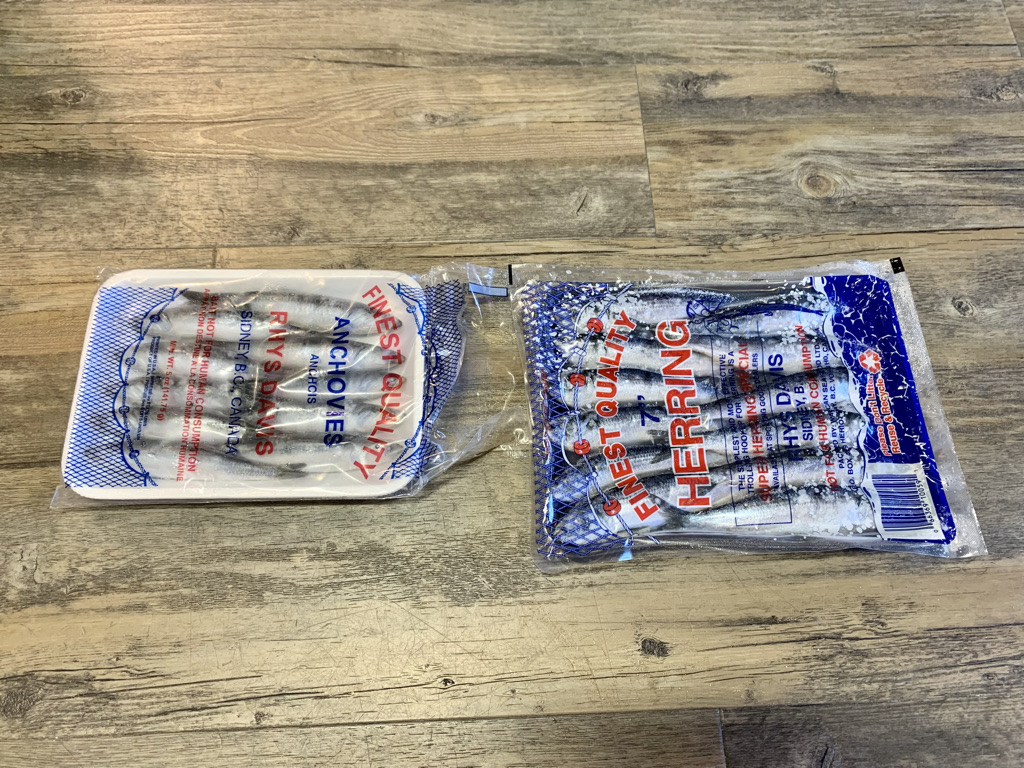
Secondly, these fish are shallow. After fishing 250-300 on the riggers the past 6 weeks over at Entrance, it’s nice to be fishing shallow. Hot depths on the riggers are 25-70 with 37, 47, and 57 being some of my favorite if I am running 3 riggers. If I am stacking, I will run a 20 to 25 foot spread and run 57 and 67. The odd day you will find fish deeper in the 70’s or 80’s but usually shallow is the way to go. These fish are up in the top part of the water column, getting used to that fresh water and trying to smell their way to the mouth of the river. They aren’t on the bottom feeding on all that bait you see on your sonar.
Above is a picture of some top producing flashers and teaser heads. On my shallower rods I like flashers that have more UV and reflective qualities, no glow needed. The first three from left to right are great choices. Twisted Sista, Betsy, and Derby Winner. On my deeper rods I like chartreuse and green flashers with some glow on one side and reflective tape on the other. The other three flashers in the picture from right to left are Lemon Lime, STS, and Salty Dawg. Pair these flashers up with some chrome teaser heads on the top rods and glow green or glow chartreuse teaser heads on your bottom rods and you will do well. For leader length I like a 6 foot leader of 30 pound test.
These past few seasons I have been running tandem 4/0 singles, no trebles, and love it. I have found my hook up to landing ratio is about the same. I will never go back to the trebles. They are a real pain when releasing smaller fish or wild coho. They also get caught up in the net. I find with the single hooks I can release fish easier, faster, with less damage to the fish and no tangles in the net. That all adds up to getting my gear back in the water faster, and that means more fish on the line. It’s a win for the fish and for the fisherman, give it a try….
Quick coho report. It’s been good off West Van for coho, so if you get your chinook limit, head on over for some coho action. Adam got a limit of chinook and then a limit of coho today, all before noon! Check out our Instagram for the photos https://www.instagram.com/pacificanglersportfishing/?hl=en
See you in the shop or on the water,
Jason Tonelli


